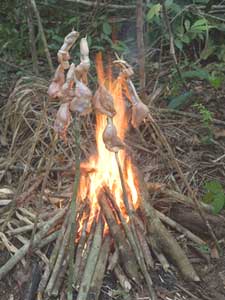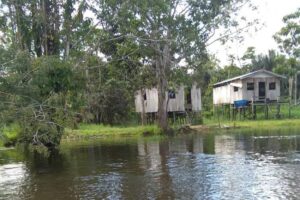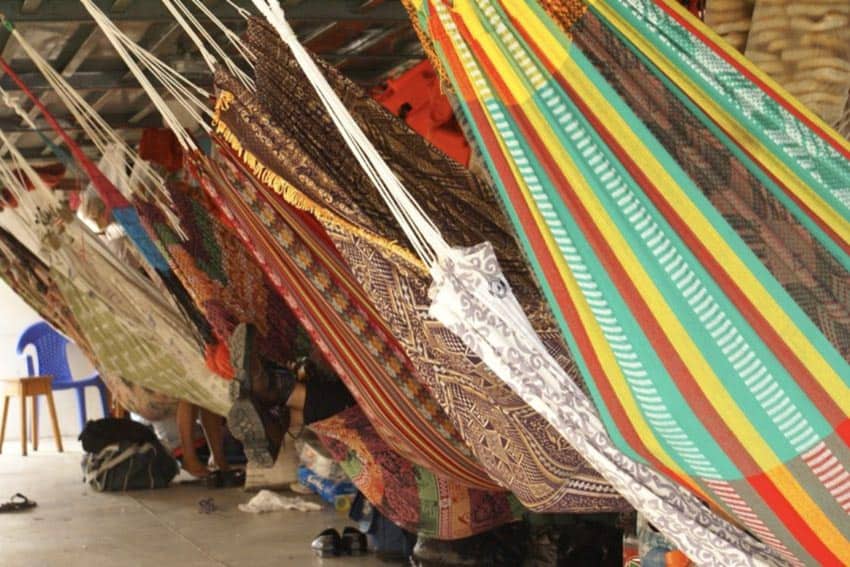
By Jason Gardner
Handle With Caution
“Yeow!” My boat mate yelped, scrambling in our dugout canoe to find something to staunch the blood gushing from his thumb. “Those little fish really bite!”
Our guides on the tour of the Amazon River in northern Brazil somehow overlooked emphasizing caution when handling the piranha – thus the first victim. We fished simply: bamboo poles, line, a hook, and a chunk of raw meat as bait. There’s no fancy reel or net – just our hands to unhook the little monsters.
Piranha fishing remains a highlight of the four-day trip. I chose a family-run agency in Manaus that provided a detailed itinerary, simple but excellent food, and hammocks instead of air-conditioned cabins. On the Amazon, our destination was the Anavilhas Islands, known for its birdlife and wild beauty.
The trip proved magical from the start – we spotted two pink dolphins (“boi de rosa” or “pink cow”) cavorting in the harbor water, coming up for air and flashing their bright pink sides. On the river, we passed palafitos — houses on stilts, guarding against the river’s rise and fall, a three-meter range during the rainy season.
Our guide, Anandi, provided more facts: the Amazon stretches over 6,000 kilometers (3,278 miles) from Peruvian Andes to the Atlantic. One-fifth of all fresh water on earth runs through the region. At its mouth, the river’s width equals the distance between Paris and London.
Statistics Fade
Yet statistics faded once we encountered the “meeting of the waters,” where the dark Rio Negro combines with the coffee-colored Rio Salimoes to form the Amazon. Our tour stayed on the Rio Negro, which houses far fewer mosquitoes because of the water is more acidic than Coca-Cola.

I quizzed Anandi about his background. “Carpentry was my first profession, and I built many houses on the Amazon River for the local people, called caboclos,” he said. Indeed, as we passed fazendas (ranches), ostrich farms, and churches in small villages, he pointed out individual homes he’d built along the banks.
“When I wanted to become a guide, first I learned everything I could about the region. Then I ventured into the wilderness with my machete, hammock, and boots for 15 days, surviving only on jungle food and my wits. It was how I tested myself.”
Anandi’s sharp eyes proved his experience. The first day we spotted a three-toed sloth hanging in the trees, moving with its trademark slowness. Turkey vultures, blue and white swallows, yellow-rumped cacique, and yellow-headed cara-cara flew overhead. Capuchin and squirrel monkeys leaped among branches and swung on their prehensile tails. The head of a caiman (crocodile) cruised among the massive water lilies.
A Rainy Night
After a long journey upriver, we tucked into a fantastic dinner, savoring tender flesh of tucunaré, a massive rainbow river bass, lightly fried to perfection by the captain’s wife in a kitchen minuscule even by New York standards.

We hit our hammocks, and soon after we fell asleep, a blowing wind heralded a quintessential tropical downpour. Side tarps protected us from gusts; I settled into a deep slumber, aided by the white noise of the rain and the gently tilting vessel.
We needed the rest for the next day’s jungle trek. Still fighting the rain, we geared up with long pants and boots (protection against snakes), insect repellent, and filled our water bottles before bushwhacking through dense foliage. While we spotted wildlife–heart spider, toucan, sleeping fruit bats, leaf-cutter ants, blue morpho butterflies–the flora proved the real highlight.
Useful Plants
Anandi pointed out innumerable plants and trees, describing each one’s uses. The water Leanna’s branches contain potable water; the tauari tree’s fibers are used as rolling papers for cigarettes. We smelled the clove wood, mahogany, and eucalyptus.

The inner bark of carapanauba or “mosquito-tree,” when ingested in tea, relieves symptoms of malaria; the sucuuba tree’s milk is used in casts for bone fractures; the inga tree’s seedpod opens to reveal orange dye used by indigenous people; the breu tree’s bark, when burned, creates resin excellent for mending leaky canoes; and the paracutaca tree or “telephone tree” booms a signal when one strikes the base.
We spent a leisurely afternoon piranha fishing, and as we brought in our catch, a grey river dolphin 20 feet away flashed its dorsal fin.
As darkness fell, we launched a marsh expedition for caiman. After some futile minutes, Anandi determined that the full moon’s light and our large group were scaring the reptiles (if they only knew the truth – we were even more scared!), so he ventured into the darkness alone, armed only with a pen flashlight. Minutes later, he returned carrying a small, live caiman that we inspected closely before throwing it back.

We began our final day canoeing through flooded forest. We heard the rat-tat-tat of the crimson-crested woodpecker, searching for food. We spotted the crowned heron before he launched to another location. The black-collared hawk, swallow-winged puff bird, and jacana circled above.
Returning to our mooring, we climbed gnarled trees jutting out of the water and cooled off with a swim before lunch. The menu? The piranha we’d caught the day before. Each bite was sweet revenge.
After, we trekked to highlands forest to camp for the evening. The rain had stopped. Our dinner consisted of roasted half chickens over an open fire, accompanied by rice and cachaça (sugar cane alcohol).
A short hike revealed wildlife like horned toads and huge spiders, with a soundtrack of cicada drones and frogs’ croaked mating calls. Back in our hammocks, we marveled at the canopy of stars and the jungle symphony that lulled us to sleep.
At dawn, Anandi woke us with one word: “Monkeys.” He pointed up to the rustling in the trees, thankful the infamous thieves didn’t pay a closer visit.
During our return trip, a visit to a native village offered a glimpse into their daily life, including the common area where they roast tapir, play soccer, and weave their huts’ roofing.
As Manaus came into sight, I reflected on this four-day mix of relaxation, adventure, natural beauty, and wildlife. Yet the map showed how little of the river we had actually seen, and how much more awaits future visits.

Jason Gardner is an award-winning travel writer and photographer based in Brooklyn, New York. He is currently documenting traditional musicians and culture in Brazil’s Northeast states. You can visit his website at jasongardner.net.
- These 9 U.S. National Parks Require Reservations in 2024 - April 17, 2024
- Take a Hike in Olympic National Park - April 17, 2024
- The Wild Mississippi: 2340 Miles Across Ten States - April 8, 2024





